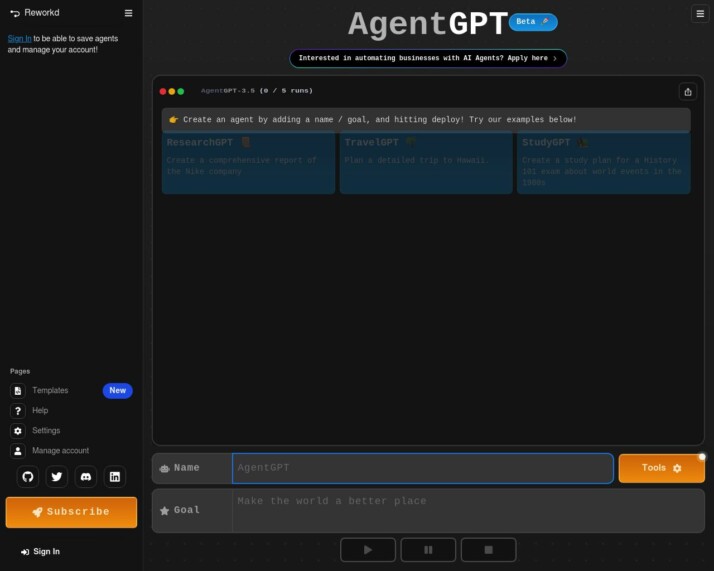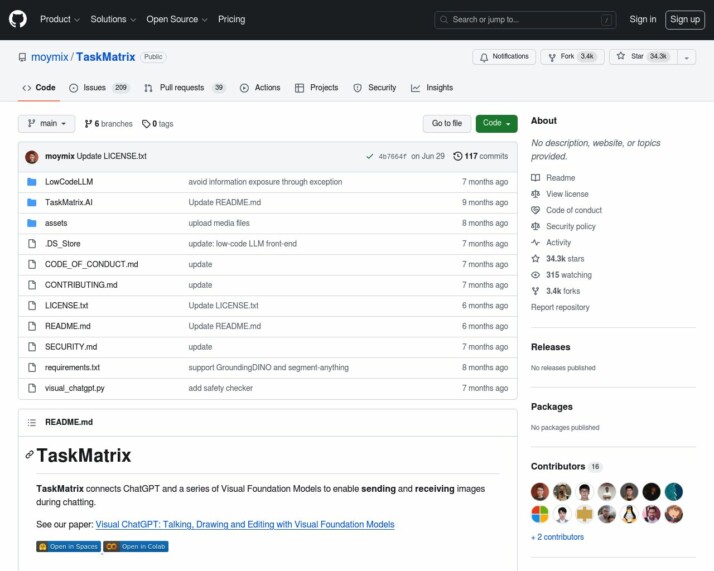Introduction
Are you struggling to compare AgentGPT vs TaskMatrix, two leading companies in the industry? Don’t worry, we’ve got you covered. In this article, we’ll provide you with a detailed comparison of these two innovative companies, highlighting their unique features and capabilities. By the end of this article, you’ll have a clear understanding of which company best suits your needs.
Are you struggling to find the right AI platform for your needs? Look no further! In this article, we will provide a detailed introduction to two leading AI platforms – AgentGPT and TaskMatrix. We will compare their features and functionalities to help you make an informed decision.
AgentGPT is an AI platform that leverages advanced AI models like GPT-3.5 and GPT-4, enabling sophisticated natural language processing and generation capabilities. It focuses on creating autonomous AI agents with advanced memory management and secure authentication capabilities. On the other hand, TaskMatrix.AI stands out with its multimodal conversational foundation model (MCFM) and innovative use of reinforcement learning with human feedback (RLHF). It aims to automate complex operations, provide transparency, and seamlessly interact with both digital and physical worlds.
Join us as we dive deep into the features, benefits, and target audiences of these two powerful AI platforms. Whether you are a developer, business professional, or innovator, this comparison will help you discover the perfect AI platform for your needs.
Discovering AgentGPT: AI for the Future
AgentGPT is an innovative AI platform designed to deliver cutting-edge AI solutions. Its key features, like autonomous AI agents and advanced memory management, make it stand apart.


The hype around AgentGPT is not unfounded—this platform utilizes advanced Large Language Models (LLM) like GPT-3.5 and GPT-4. These AI models facilitate sophisticated natural language processing, enabling the AI agents to function independently—a major leap towards self-managing AI systems.
Additionally, AgentGPT prioritizes seamless integration and security. It supports OAuth authentication, providing secure and user-friendly access control.
With an emphasis on handling complex data structures, it uses Weaviate, a hosted vector database for optimal memory management. This emphasis underscores AgentGPT’s commitment to enhancing the AI agent’s context understanding abilities.
The company’s vision for the future involves creating an AI platform where agents can be given tasks and objectives. It appears they’ve initiated this vision with the launch of a product aligning closely, although specifics about its deployment and operation are still under wraps.
It seems AgentGPT’s target audience is users with technical expertise, including software developers, AI researchers, IT professionals, and data scientists. However, its ability to handle complex workflows makes it a valuable tool for businesses and organizations of all types, too.
In conclusion, AgentGPT offers a unique blend of AI model integration, data handling capabilities, and workflow management tools. Despite some details on deployment and hosting remaining undisclosed, its vision of autonomous operation is notable, promising an advanced, yet practical AI solution for various applications.
Understanding TaskMatrix: The AI Powerhouse
Imagine an AI platform that can perform a wide range of complex tasks across different fields. Such a tool exists – its name is TaskMatrix.


It’s a unique platform that develops tasks using an advanced Multimodal Conversational Foundation Model, or MCFM for short. TaskMatrix can understand instructions in many formats and then create codes to carry out tasks.
But that’s not the only thing that makes TaskMatrix unique. It uses reinforcement learning with your feedback to make its models even better. This means the more feedback you provide, the better TaskMatrix can perform. It aims to be clear and transparent, providing crucial feedback for API developers.
Here are some more distinctive features:
- API platform for storing and managing APIs
- API selector for tasks
- Action executor for running the APIs
These features help TaskMatrix automate a variety of tasks, such as office automation, cloud service utilization and controlling robotics and IoT devices. It can even understand and execute instructions through voice, making it even more user-friendly!
But who is TaskMatrix for? The target audience includes developers, engineers, business professionals, and office workers, among others. It works well for anyone who wants to integrate complex AI functionalities into their applications.
As for the future, TaskMatrix is planning to create an AI system that can seamlessly interact with both the digital and physical world. This forward-thinking vision means TaskMatrix has the potential to be a versatile tool for a wide range of applications.
Comparing Key Features of Chatbot Platforms: AgentGPT vs TaskMatrix and SmythOS
In the rapidly evolving landscape of AI chatbot platforms, understanding each platform’s unique capabilities can help in making an informed decision. This feature comparison section aims to decode the core functionalities of three such platforms – AgentGPT, TaskMatrix, and SmythOS.
| Features | AgentGPT | TaskMatrix | SmythOS |
|---|---|---|---|
| Hosted Agents (Dev, Production) | ✅ | ❌ | ✅ |
| Environments (Dev, Production) | ❌ | ✅ | ✅ |
| Visual Builder | ❌ | ❌ | ✅ |
| No-Code Editor | ❌ | ❌ | ✅ |
| Memory & Context | ✅ | ✅ | ✅ |
| Autonomous Agents | ✅ | ✅ | ✅ |
| Explainability and Transparency | ❌ | ✅ | ✅ |
| Debug Mode | ❌ | ✅ | ✅ |
| Multimodal | ❌ | ✅ | ✅ |
| Problem-Solving Capabilities | ✅ | ✅ | ✅ |
From the comparison table, it is evident that while AgentGPT and TaskMatrix each have notable features, both platforms lack in certain areas compared to SmythOS. AgentGPT, for instance, fall short in terms of providing environments for both development and production stages. Similarly, TaskMatrix while excelling at multimodal communication and integrated debugging exercises, falls behind when it comes to a no-code editor. This comparison articulates that despite some differences, each platform excels in their unique way, making them suitable for varied user expectations.
The impact of these features on the end users can be monumental. The availability of a no-code editor, for instance, can significantly reduce the complexity of creating AI-driven chatbots. Similarly, features like autonomous agents and problem-solving capabilities add value by mimicking human-like conversation while resolving user queries. Therefore, a careful examination of these features and their implications can guide users to choose the best-fit AI chatbot platform for their respective needs.
However, it is worth noting that SmythOS seems to be a superior choice as it has all the mentioned features available. End users would need to consider their specific needs and the tasks they seek to automate when choosing between these platforms.
AgentGPT vs TaskMatrix: Audience Analysis
This section explores the target audience for both AgentGPT and TaskMatrix, identifying who benefits most from each product’s features and applications.
AgentGPT
- Audience: AgentGPT is primarily designed for professionals and organizations in the software development and technology sectors.
- Target Audience: The intended audience for AgentGPT includes software developers and engineers, project managers and product managers, startups and entrepreneurs, companies looking for automation solutions, technology innovators and experimenters, and AI and machine learning enthusiasts.
- Features and Applications: AgentGPT offers a multi-agent collaborative framework, uses advanced AI models, and provides AI assistants and tools for a variety of tasks such as software development, project management, automation, and exploring new applications of AI in software development.
TaskMatrix
- Audience: TaskMatrix.AI caters to a diverse range of users with its comprehensive and multimodal AI functionalities.
- Target Audience: The target audience for TaskMatrix.AI includes developers and engineers, business professionals and office workers, product managers and innovators, IoT and robotics enthusiasts, educators and researchers, and end users seeking personalized AI assistance.
- Features and Applications: TaskMatrix.AI is highly suitable for developers and engineers, offers capabilities in automating business tasks, has multimodal interaction capabilities, and can control robotics and IoT devices. It is also designed to assist educators, researchers, and individuals seeking personalized AI assistance.
AgentGPT and TaskMatrix offer accessible and user-friendly platforms that cater to a diverse audience, ranging from professionals in various industries to non-experts interested in leveraging AI. These features make both AgentGPT and TaskMatrix particularly appealing to those with technical expertise in software development and AI technologies.
Conclusion
SmythOS, an AI-driven operating system, emerges as the superior choice when comparing it to AgentGPT and TaskMatrix. With its comprehensive and flexible AI integration capabilities, scalable infrastructure, and wide range of deployment options, SmythOS stands out in enhancing the functionality and accessibility of AI technologies across various sectors.
SmythOS offers a host of features that cater to different user needs. It provides a visual builder for creating complex workflows without coding, making it easy to use for both technical experts and business users. The no-code editor enables users to modify workflows effortlessly. Utilizing datalake components, SmythOS allows agents to store, retrieve, and update information over time, promoting memory and experience-based learning.
Furthermore, SmythOS supports the creation of autonomous AI agents that continuously adapt and learn from their environment. Its advanced debugging tools and logging capabilities ensure explainability and transparency in the decision-making processes of AI agents.
Professionals responsible for optimizing IT infrastructure can benefit from SmythOS’s scalability and efficient resource allocation, ensuring cost-effectiveness. Marketing and web management teams can utilize its site and URL crawling capabilities to understand and interact with web content, crucial for digital marketing and online presence.
Overall, SmythOS caters to a diverse audience, from technical experts in AI to business users in need of AI-driven solutions. Its features and applications address a wide range of needs, from flexibility and ease of use to advanced AI capabilities and efficient resource management.
Last updated:
Disclaimer: The information presented in this article is for general informational purposes only and is provided as is. While we strive to keep the content up-to-date and accurate, we make no representations or warranties of any kind, express or implied, about the completeness, accuracy, reliability, suitability, or availability of the information contained in this article.
Any reliance you place on such information is strictly at your own risk. We reserve the right to make additions, deletions, or modifications to the contents of this article at any time without prior notice.
In no event will we be liable for any loss or damage including without limitation, indirect or consequential loss or damage, or any loss or damage whatsoever arising from loss of data, profits, or any other loss not specified herein arising out of, or in connection with, the use of this article.
Despite our best efforts, this article may contain oversights, errors, or omissions. If you notice any inaccuracies or have concerns about the content, please report them through our content feedback form. Your input helps us maintain the quality and reliability of our information.
Alexander De Ridder
Co-Founder, Visionary, and CTO at SmythOS. Alexander crafts AI tools and solutions for enterprises and the web. He is a smart creative, a builder of amazing things. He loves to study “how” and “why” humans and AI make decisions.
Explore All Comparison Articles
Decisions vs. Sola: AI Workflow Automation Showdown
AI-powered workflow automation platforms revolutionize how businesses streamline operations and boost productivity. This comparison explores Decisions vs. Sola, and SmythOS,…
DeepOpinion vs. Sola: Comparing AI Automation Platforms
AI-powered automation platforms revolutionize business operations, but choosing the right solution can be challenging. This comparison of DeepOpinion vs. Sola,…
DevGPT vs. Sola: AI-Powered Development Tools Compared
AI-powered development tools revolutionize software creation, offering unprecedented efficiency and capabilities. This comprehensive review compares DevGPT vs. Sola, and SmythOS,…
Fine AI vs. Sola: Comparing AI Automation Tools
AI-powered automation transforms software development and business workflows, offering unprecedented efficiency and innovation. Fine AI vs. Sola present distinct approaches…
FlowiseAI vs. Sola: Comparing AI Automation Platforms
AI-powered automation revolutionizes business operations, driving efficiency and innovation across industries. FlowiseAI vs. Sola offer distinct approaches to harness this…
Gooey AI vs. Sola: AI-Powered Automation Platforms Compared
AI-powered automation platforms revolutionize how businesses streamline operations and enhance productivity. This comparison delves into Gooey AI vs. Sola, two…

